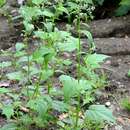fr
noms dans le fil d’Ariane


Chenopodiastrum ist eine 2012 beschriebene Pflanzengattung aus der Unterfamilie Chenopodioideae in der Familie der Fuchsschwanzgewächse (Amaranthaceae). Die sechs Arten kommen in Eurasien, Afrika und Nordamerika vor.
Chenopodiastrum-Arten sind einjährige krautige Pflanzen ohne aromatischen Duft. Junge Pflanzen besitzen Blasenhaare, die später völlig zusammenfallen und abgeworfen werden, so dass die Pflanzen verkahlen. Die Stängel wachsen aufrecht und sind verzweigt.
Die wechselständigen Laubblätter sind in Blattstiel und Blattspreite gegliedert. Die dicklichen Blattspreiten können dreieckig, eiförmig, oder rhombisch-eiförmig bis lanzettlich geformt sein. Der Blattrand ist unregelmäßig gezähnt, gelappt oder fiederspaltig mit schmalen gezähnten Lappen.
Die Blüten befinden sich in kleinen, dicht knäueligen Teilblütenständen, die zu scheinährigen oder traubigen Blütenständen angeordnet sind. Diese stehen in den Blattachseln oder endständig. Die zwittrigen oder rein weiblichen Blüten besitzen fünf an der Basis verbundene Blütenhüllblätter mit einer starken, von innen sichtbaren Mittelrippe und einem deutlichen Kiel an der Spitze. In zwittrigen Blüten ist ein Kreis von fünf Staubblättern vorhanden. Die Fruchtblätter sind zu einem oberständigen Fruchtknoten mit zwei Narben verwachsen.
Zur Fruchtzeit kann die Blütenhülle die Frucht umschließen oder abspreizen. Die häutige Fruchtwand haftet fest an der Samenschale. Der horizontal orientierte Samen ist linsenförmig, mit scharfem oder stumpfem Rand. Die schwarze Samenschale ist oft deutlich grubig oder runzelig, selten fast glatt.
Die Gattung Chenopodiastrum wurde 2012 von Suzy Fuentes-Bazan, Pertti Uotila und Thomas Borsch (in A novel phylogeny-based generic classification for Chenopodium sensu lato, and a tribal rearrangement of Chenopodioideae (Chenopodiaceae). in Willdenowia 42, S. 14) neu beschrieben. Damit wurden mehrere bislang zu Chenopodium gestellte Arten abgetrennt, die nach molekulargenetischen Untersuchungen nicht zu dieser Gattung im engeren Sinne gehören.
Chenopodiastrum wurde von Fuentes et al. wie Chenopodium in die Tribus Atripliceae eingruppiert und gehört zur Unterfamilie Chenopodioideae innerhalb der Familie der Amaranthaceae s. l.
Die Gattung Chenopodiastrum ist in Europa, Asien, Afrika und Nordamerika verbreitet.[1][2]
Die Gattung umfasst nach Fuentes-Bazan (2012) und Mosyakin (2013)[3] sechs Arten in zwei Sektionen:
Chenopodiastrum ist eine 2012 beschriebene Pflanzengattung aus der Unterfamilie Chenopodioideae in der Familie der Fuchsschwanzgewächse (Amaranthaceae). Die sechs Arten kommen in Eurasien, Afrika und Nordamerika vor.
Chenopodiastrum is a genus of herbaceous flowering plants in the family Amaranthaceae. The genus was formally described in 2012.[2] [3] The 5 species occur in Eurasia, North Africa, and North America.[3]
The species in genus Chenopodiastrum are non-aromatic annual herbs. Young plants have vesicular trichomes, that later collapse and fall down, thus plants becoming glabrescent. Stems grow erect, with lateral branches. The alternate leaves have a petiole and a thickish triangular, ovate, rhombic-ovate to lanceolate leaf blade. The leaf margin can be irregularly dentate or lobed, or pinnatifid with narrow dentate lobes.
The axillary and terminal inflorescences consist of small dense glomerules of flowers, arranged spicately or paniculately. Flowers are bisexual or pistillate. They contain 5 basally connate perianth segments with a prominent keel near the apex, and a characteristic strong midrib visible from the inside; a circle of 5 stamens; and an ovary with 2 stigmas.
In fruit, the perianth lobes enclose the fruit or spread. The membraneous pericarp adheres firmly to the seed. The horizontally orientated seeds are lenticular. The black seed coat is often prominently pitted, sometimes rugulose or nearly smooth.
The genus Chenopodiastrum was described in 2012 by Suzy Fuentes-Bazan, Pertti Uotila und Thomas Borsch (in: A novel phylogeny-based generic classification for Chenopodium sensu lato, and a tribal rearrangement of Chenopodioideae (Chenopodiaceae). in Willdenowia 42, p. 14). After phylogenetic research, this group of species had to be separated from genus Chenopodium, that would otherwise have been polyphyletic.[2] The genus Chenopodiastrum belongs to the same tribe as Chenopodium, Tribus Atripliceae.[2]
Chenopodiastrum consists of 5 species,[2] occurring in Eurasia, North Africa, and North America:
{{cite web}}: Missing or empty |title= (help) {{cite web}}: Missing or empty |title= (help) {{cite web}}: Missing or empty |title= (help) Chenopodiastrum is a genus of herbaceous flowering plants in the family Amaranthaceae. The genus was formally described in 2012. The 5 species occur in Eurasia, North Africa, and North America.